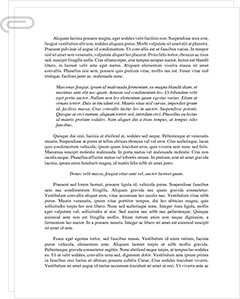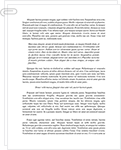 Study Document
Study Document
Police Mentally Ill Policing and Mentally Ill Term Paper
Pages:3 (952 words)
Sources:3
Subject:Government
Topic:Police Training
Document Type:Term Paper
Document:#57895589
Police Mentally Ill
Policing and Mentally Ill Individuals
There is a significantly higher proportion of mentally ill individuals in the criminal justice system than compared to the same proportion of the United States in the society in general. It is estimated that a mentally ill individual is about eight times more likely to enter into the criminal justice system than they are a mental hospital. These individuals, as the video and the interview illustrates, have special challenges that make them difficult to deal with. Often they hear voices and are paranoid schizophrenics that require a host of special medications to allow them the possibility of being stable. However, many of these individuals face specific challenges that make it difficult for them to access and maintain an effective treatment regimen. This paper will provide a brief overview of how this situation arose and what implications it has for modern police forces.
It is important to put this problem in its historical context to fully understand how the situation arose. During the 1950s and the 1960s the United States began to change the way it thinks about the mentally ill. Legislators began to close state run mental hospitals that provided care for patients that were in need of mental health services. These individuals were left to attempt to access services from the different communities in which the lived rather than the state facilities. As a result, many of these patients no longer were able to receive the care that they needed. In 1955 there were 558,239 public (state and county) psychiatric beds available for mentally ill individuals and the population of the United States was 164.3 million which resulted in the availability of public psychiatric beds was thus 340 beds per 100,000 population; however, in 2005 there were 52,539 public (state and county) psychiatric beds available for mentally ill individuals and at this time the population of the United States was 269.4 million resulting in the availability of public psychiatric beds was thus 17 beds per 100,000 population (Torrey, Geller, Stanley, & Jaffe, N.d.).
By closing these facilities, many mentally ill patients lost their access to mental health care and no longer received treatment of any kind for a variety of reasons; mainly that there was excess demand for services that could not be met by the community facilities. Since many of these individuals could no care for their basic needs, many of these people ended up homeless or in prison. Some of the cases of people with mental illnesses would ultimately lead to violence if their conditions were untreated. In the documentary some of the ex-prisoners would hear voices…
Sample Source(s) Used
Works Cited
CIT International. (N.d.). Mephis Model. Retrieved from CIT International: http://www.citinternational.org/training-overview/163-memphis-model.html
Conan, N. (2012, April 2). A Patient's Perspective: Police and the Mentally Ill. Retrieved from NPR: http://www.npr.org/2012/04/02/149857042/a-patients-perspective-police-and-the-mentally-ill
PBS. (2009, April 28). The Released. Retrieved from Frontline: http://video.pbs.org/video/1114528522/
Torrey, E.E., Geller, J., Stanley, J., & Jaffe, D. (N.d.). The Shortage of Public Hospital Beds for Mentally Ill Persons. The Treatment Advocacy Center, 1-17.
Related Documents
 Study Document
Study Document
Police and Chronic Mentally Ill
As this study points out, these encounters can lead to negative situations and even to death, injuries and legal issues. In essence, the relationship and involvement of the police from a formal point-of-view is based on two common law principles. These are, the facility and the responsibility of the police to protect the safety and welfare of the public, and secondly the principle of parens patriae, which dictates protection for
 Study Document
Study Document
Police Brutality There Are Certainly "Cons" When
Police Brutality There are certainly "cons" when discussing the problem of police brutality, but are there also positives ("pros") when those events occur? This paper points to the issue of police brutality from several viewpoints and critiques the literature. Police Brutality Cases on the rise since 9/11 Incidents in which police, prison guards or other law enforcement authorities have used "excessive force" or otherwise have violated civil rights "…have increased 25% from
 Study Document
Study Document
Police Discipline
The problem with hiring an internal investigator in that his judgment, in most cases, may be clouded by friendship, bias or even personal grudges. Another possible solution would be office shuffling. This police tradition is usually repugnant, superfluous to the public, and ineffective in dealing with the problems in the police. Office shuffle is only effective if competent officers and dedicated to combating police problems replace non-performing officers. For
 Study Document
Study Document
Police Officers and Police
Murderer-Season 1, Episode This episode focuses on the complexities of the investigation of Avery, given that he had a civil suit against the county that was investigating him for the murder of Halbach. As a result, as officers were gathering evidence, they were under the supervision of an outside police force. The outside officers testified that the investigation was carried out under acceptable protocols although when incriminating evidence was found
 Study Document
Study Document
Mental Illness and the Police
To the Editor:Recently, there has been a crisis of confidence in the ability of the criminal justice system and the police system to act fairly toward persona of all races, religions, and ethnicities. This is also true of persons with disabilities. Particularly of suspects of persons with mental illnesses, including schizophrenia, autism, and developmental disabilities, it can be very difficult for untrained officers to distinguish between criminality and mental illness.Ethical
 Study Document
Study Document
Terrorism Impact on Police Mission
terrorism has impacted the police mission in the U.S. Be sure to provide examples. Describe at least two disagreements that exist regarding the appropriate law enforcement behavior to fight terrorism and maintain personal liberties? Terrorism and the events connected to September 11, 2001 have impacted the world in ways we could never imagine, affecting the way we view our safety and the way that we view ourselves. State and local



